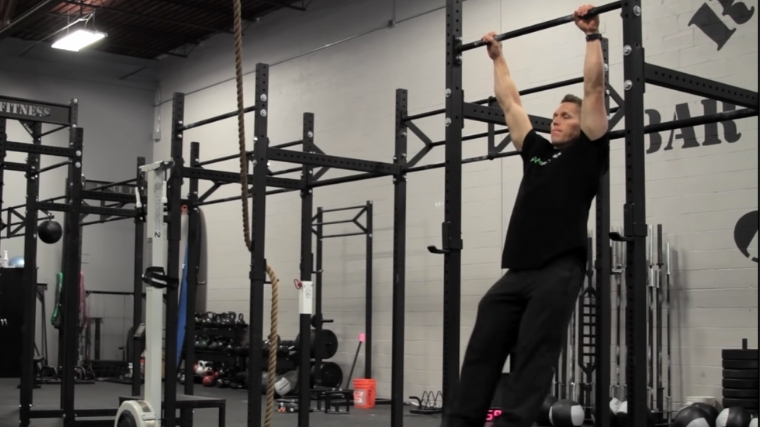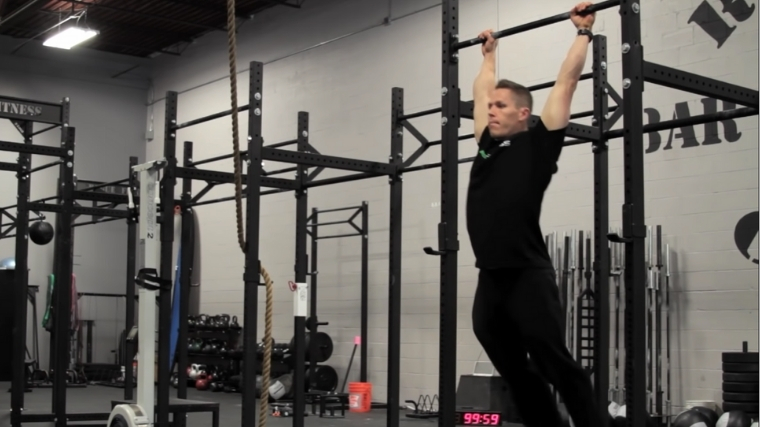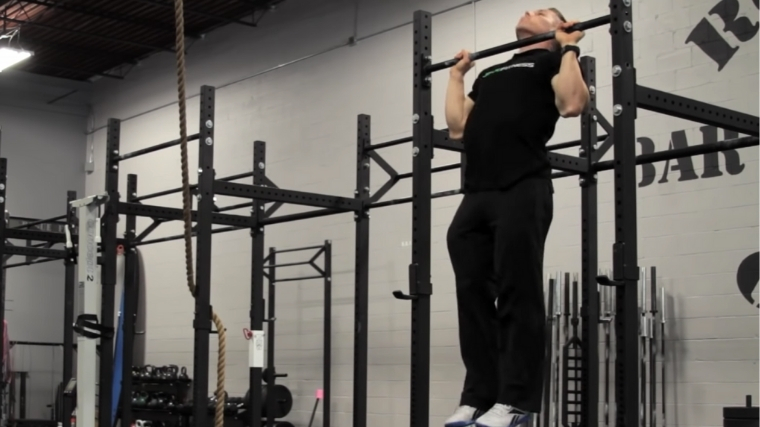A kipping pull-up isn’t cheating. Nor is it a traditional pull-up. This momentum-happy pull-up variation is popular among CrossFitters who need to bang out hundreds of reps. The lifter athletes fling their body weight around to get their chin over the bar more efficiently. The kipping pull-up doesn’t place much tension on the back, but the sheer volume that the exercise allows enhances grip strength, enhances muscular endurance, and is a pretty solid conditioning tool.
And although it looks like a pull-up gone wrong, the kipping pull-up requires a lot of technique and skill. Here’s how to do the kipping pull-up, along with variations, alternatives, set and rep suggestions, and the answers to your pull-up questions.
- How to Do the Kipping Pull-Up
- Benefits of the Kipping Pull-Up
- Muscles Worked By the Kipping Pull-Up
- Who Should Do the Kipping Pull-Up
- Kipping Pull-Up Sets, Reps, and Programming Recommendations
- Kipping Pull-Up Variations
- Kipping Pull-Up Alternatives
- Frequently Asked Questions
How to Do the Kipping Pull-Up
The kipping pull-up is, typically, is complex — it requires control, muscle endurance, and skill. The kipping portion of the pull-up can also be applied to the chest-to-bar kipping pull-up (which is the same movement except that the lifter brings the chest to the bar instead of the chin). Below is a step-by-step guide on how to perform the kipping pull-up.
Step 1 — Grip a Bar

Grab a pull-up bar with a shoulder-width or slightly wider than shoulder-width grip. You can take a thumbless grip or full grip. Hang from the bar with your arms fully extended.
Form Tip: Focus on maintaining core stability and midline control. Though it looks like the athlete is flopping around, they’re actually demonstrating a lot of core control.
Step 2 — Initiate the Kip

To initiate the kip, drive your head through your arms and squeeze your shoulder blades together to arch your back. Reverse that position, so your core appears hollow, and your back is round. Oscillate between the arched and hollow positions to create momentum.
Form Tip: You shouldn’t feel a twinge in your back. If you do, stop.
Step 3 — Push the Bar Down, Pull Yourself Up, Drop, and Repeat

From the arched position, drive the legs and hips towards the bar while simultaneously pushing down on the bar. Pull with the arms until the chin is above the bar (or chest hits the bar).
Form Tip: Allow the torso to move forward as you descend, placing you into a good arched position as you reach the bottom.
Benefits of the Kipping Pull-Up
Below are four benefits of the kipping pull-up that coaches and athletes can expect to gain when programming these within a training program.
Grow a More Muscular Back
Strict pull-ups are the way to go if you want a bigger back — you can better isolate the target muscles and sustain tension for longer. That said, some kipping pull-up variations, like the butterfly kipping pull-up, may help to increase muscle hypertrophy (growth) when paired with strict pull-ups. You can perform many reps with kipping pull-ups, which will lead to more muscle damage.
Over time, the extra volume can increase muscle growth as long as the lifter has their recovery dialed in. Again, be advised that strict, regular pull-ups are key for adding strength and muscle mass, whereas kipping variations may help the process, but they’re not essential.
Improve Pull-Up Efficiency
CrossFitters and functional fitness athletes love kipping pull-ups because they’re A) quicker than standard pull-ups, and B) they can do a heck of a lot more reps. Also, using momentum to aid the movement saves energy over time, which is important if you’re competing.
[Related: The 6 Best Rotational Strength Exercises Worth Adding to Your Workout]
This movement may not necessarily be the best at building strength and muscle mass (see below). Still, it can help to increase the volume of this pull-up motion (more repetitions being completed).
Improve Your Gymnastics Skill
Pull-ups as a whole are important for the performance in gymnastics and competitive fitness, as it lays a foundation for overall strength, body control, and motor development needed for more advanced bodyweight movements such as muscle-ups. While the standard pull-up builds back strength, the kipping pull-up enables you to access that strength and use it to propel yourself over the bar or up onto a pair of rings.
Better Grip Strength and Endurance
One thing that the kipping pull-up and traditional pull-up have in common: You need a crushing grip to pull either off. That said, the kipping pull-up helps to develop your grip strength better as you’re hanging onto the bar for longer (since you’re doing more reps).
Muscles Worked By the Kipping Pull-Up
The kipping pull-up affects the same muscles as the pull-up, but in a different way. Here’s a list of the main muscles you can expect to start burning mid-set.
Latissimus Dorsi
The back muscles are the primary muscle group used in this exercise. Much like the pull-up or other vertical pulling movements, the back works to pull the lifter up to the bar.
Forearms
The forearms and grip muscles are the bridge between the lifter’s hands and back muscles. Constant tension is on these muscles for the duration of the exercise.
Biceps
The biceps flex the elbow to help pull the lifter up to the bar. The lifter must rely heavily on the back muscles, especially during the eccentric phase of this movement, to protect the biceps from excessive stress and overload.
Scapular Stabilizers
The scapular stabilizers keep the shoulders anchored so the lifter doesn’t lose tension throughout the movement. Due to the extremely ballistic nature of this movement and the added stress placed upon the rotator cuff and posterior shoulder, it is recommended that only advanced lifters and those who are capable of performing these with proper form do kipping pull-ups.
Who Should Do the Kipping Pull Up?
Below are some reasons why strength, power, and fitness athletes can benefit from performing the kipping pull-up.
Strength and Power Athletes
There’s not a lot of value in doing kipping pull-ups for strength athletes. Serious strength athletes — strongman, powerlifters, Olympic weightlifters — need strong backs built with loaded exercises like barbell rows, dumbbell rows, and deadlifts. Strict pull-ups are used to help grow the muscles and increase strength, too. Though useful for building grip strength and endurance, Kipping pull-ups are too low on the accessory movement priority list to be deemed useful.
Fitness Athletes
These athletes perform kipping pull-ups in competition, and so doing kipping pull-ups makes sense. In this instance, it’s sport-specific and will help these athletes acquire the skills they need to win.
The General Population
Again, kipping pull-ups are ultra-specific and, in some cases, can be dangerous if not done with proper form. For folks just starting, focus on tried-and-true muscle-building movements and basic pull-ups.
[Related: How to Perform the Push-Up — Tips, Tricks & Variations]
Kipping Pull-Up Sets, Reps, and Programming Recommendations
Here are some set and rep schemes that you can try out based on goals. Remember that these are just starting points. Adjust the numbers below to fit your specific goals and o match your ability.
To Improve Technique
Like any gymnastic movement, practice makes perfect, and the kipping pull-up takes time and emphasis on proper positions, stability, and timing. For this reason, it is recommended that lifters perform these in small doses, working on getting the kipping movement mastered in the three to five rep range for many smaller sets and slowly building up their capacity to train in higher repetitions without breaking down form.
To Enhance Muscle Endurance
For improved muscle endurance, the lifter should aim to hit rep ranges that force them to be in motion and performing good repetitions for 30-90 seconds per set. This is specific to the goals of the sport and the level of the athlete.
To Increase Sport Specific Skill
As discussed above, if the individuals need to improve technique, fewer reps and more sets can be done to increase the proficiency of the movement. If the athlete needs to improve movement efficiency during longer sets or develop muscular endurance specific to this movement, refer to the above endurance recommendation.
Kipping Pull-Up Variations
Below are two kipping pull-up variations that coaches and athletes can use to keep training varied and progressive.
Kipping Butterfly Pull-Up
The kipping pull-up is a variation of the kipping pull-up. However, the lifter continuously cycles through the kipping movement to stay in motion and be more efficient than a standard kip. The movement is slightly more efficient and better for longer rep sets or conserving pull-up energy by performing the butterfly motion.
[Related: The Best Leg Exercises for Muscle, Strength, and More]
Chest-to-Bar Butterfly Kipping Pull-Up
The chest-to-bar kipping pull-up has an individual perform a standard kipping pull-up. However, they must touch their chest to the bar rather than getting their chin above the bar. This requires greater strength and skill and is often used as a more advanced pull-up variation in competitive fitness. It also can translate over to muscle-ups to a higher degree.
[Related: The 7 Best Triceps Exercises for More Mass and a Bigger Bench Press]
Kipping Pull-Up Alternatives
Below are three kipping pull-up alternatives coaches and athletes can use to increase back strength and muscle hypertrophy/endurance.
Strict or Assisted Pull-Up
If you are strictly looking to increase back strength and muscle growth, it is suggested that you train the pull-up strict or with some assistance (band or machine help). By not kipping, you minimize momentum used, which makes the movement of getting up to a bar easier (kipping requires less strength), but in turn, decreases the stimulus to the back muscles unless you do many more repetitions (more is not always better).
[Related: How to Incorporate Bands and Chains Into Your Weight Training]
Inverted Row
The inverted row is a regression of the pull-up. However, it can increase back hypertrophy, grip strength, and muscular endurance in all level lifters. This is a great way to add extra back and grip straining and develop core stability and body control without the ballistic and potentially injurious stress that the butterfly kipping pull-up may place on beginners or less skilled individuals.
[Related: The One-Month-Long Beginner Pull-Up Program]
Muscle-Up
The muscle-up is a far more advanced alternative to the kipping pull-up. It involves a lifter performing a kipping pull-up to a bar or set of gymnastic rings and go into a dip before cycling through another repetition. This offers many of the same benefits as the butterfly kipping pull-up. However, it also offers the benefit of increased upper body pressing strength (dips).
[Related: Everything You Need to Know to Build Your First Workout Program]
FAQs
Are kipping pull-ups dangerous?
Kipping pull-ups are ballistic and can be dangerous to do if you do not have adequate pull-up strength (strict pull-ups), muscle hypertrophy, and control. Many lifters will injure themselves because they rely on momentum rather than controlling the body and having enough strength to support the movement.
Are kipping pull-ups easier than regular pull-ups?
While the skill needs may be higher during a kipping butterfly pull-up, the actual strength and muscle mass needed to perform one is less than a strict pull-up.
How heavy can I train kipping pull-ups?
Training kipping pull-ups heavier than your own body weight can be done. However, you runs a higher risk of increased muscle damage, muscle injury, and joint stress. If you are doing kipping pull-ups to increase back strength, you are better off performing strict movements like strict pull-ups or rows and adding weight there, while using kipping and more ballistic movements to increase sport-specific skills.
Featured image: Baranq/Shutterstock